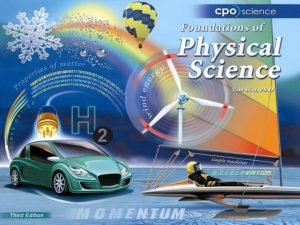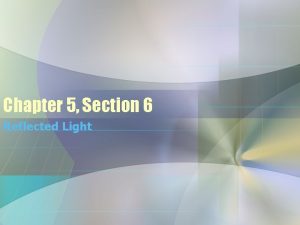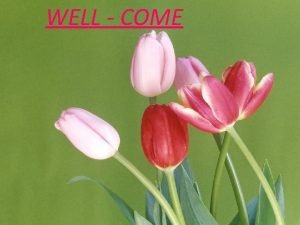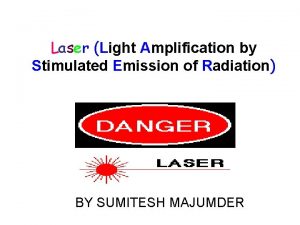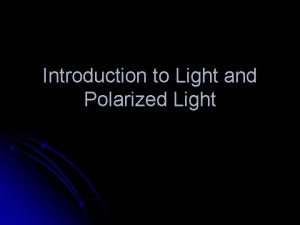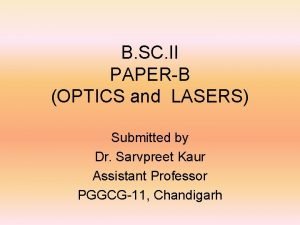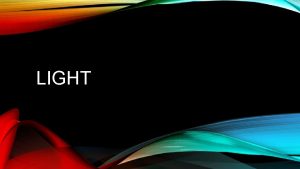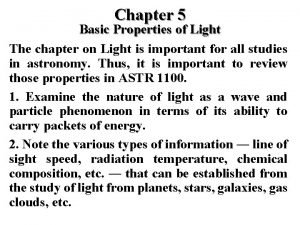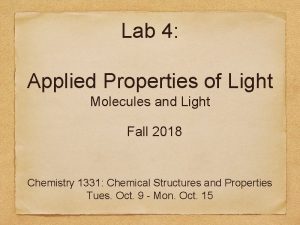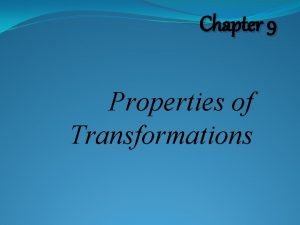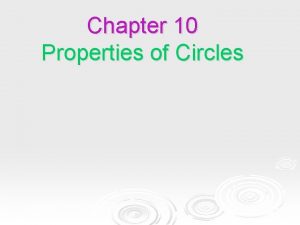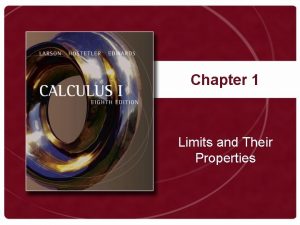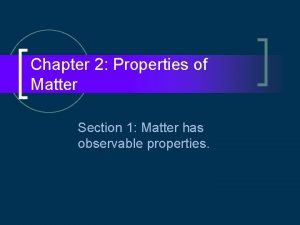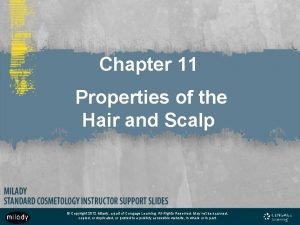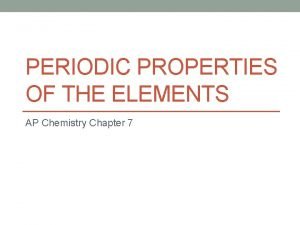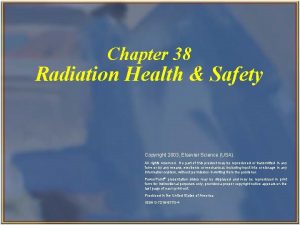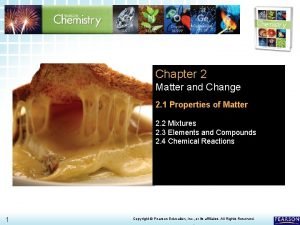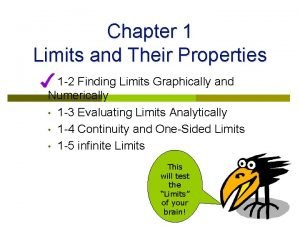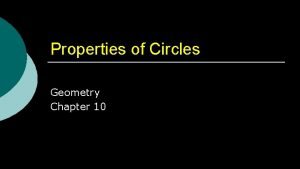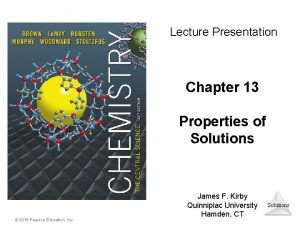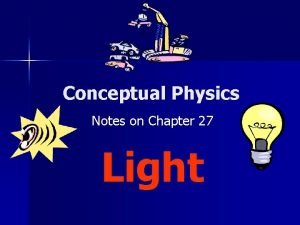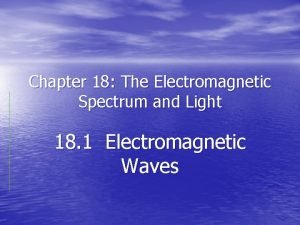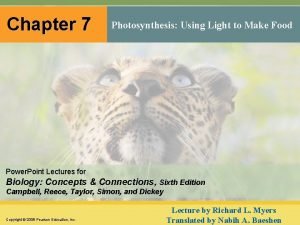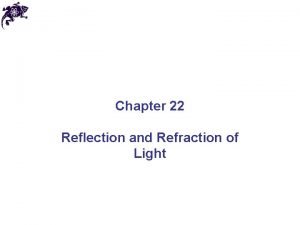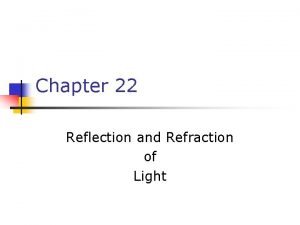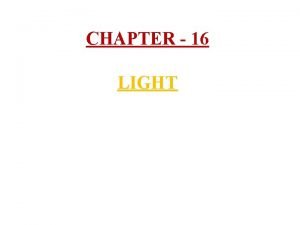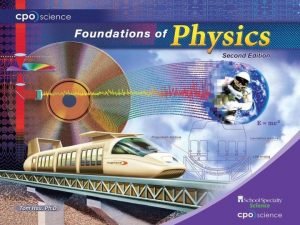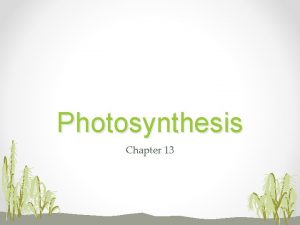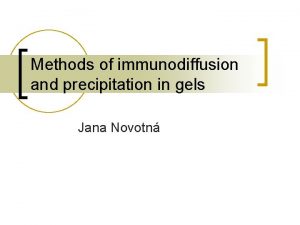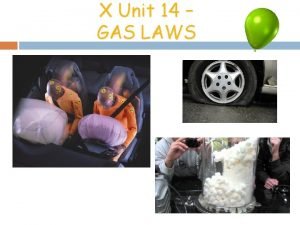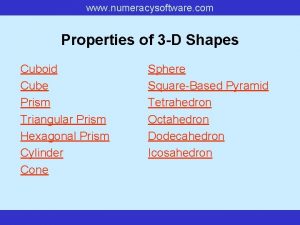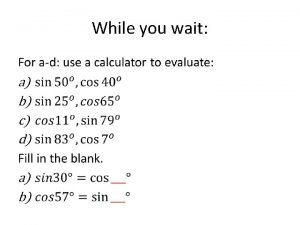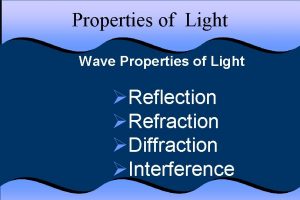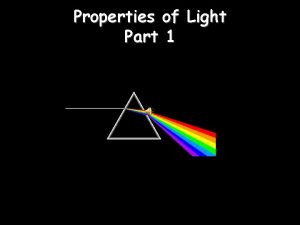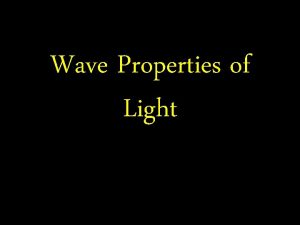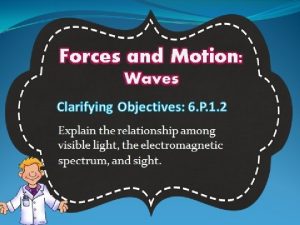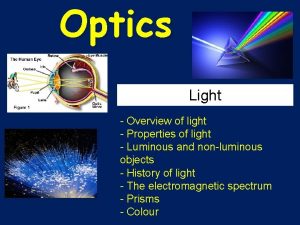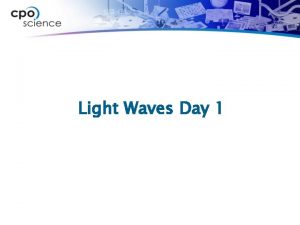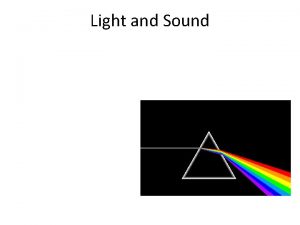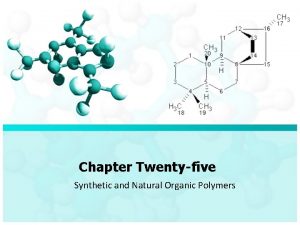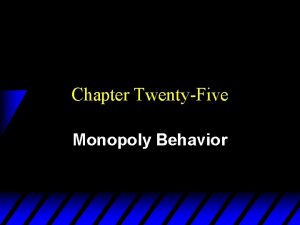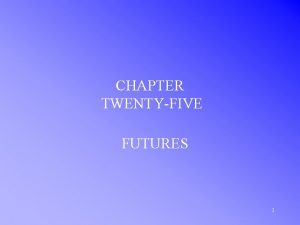Chapter TwentyFive Light 25 1 Properties of Light




















































- Slides: 52


Chapter Twenty-Five: Light Ø 25. 1 Properties of Light Ø 25. 2 Color and Vision Ø 25. 3 Optics

25. 1 Properties of light ØLight travels fast over long distances and carries energy and information. ØLight travels in straight lines, but can be bent by lenses or reflected by mirrors heat and warmth. ØLight has color and can be bright or dim.

25. 1 The electromagnetic spectrum ØLight, like sound and heat, is a form of energy. ØThe visible light we see is part of the electromagnetic spectrum.

25. 1 Properties of light ØYou see book pages because light in the room reflects from the page to your eyes. ØYour eyes and brain use the information carried by the light to make a mental picture.

25. 1 Light is produced by atoms ØMost light is produced by atoms. ØWhen you put some energy into the atom, it excites the atom’s electrons. ØLight is produced when the electron releases this energy.

25. 1 Incandescent light ØMaking light with heat is called incandescence. ØAtoms in the filament convert electrical energy to heat and then to light. ØIncandescent bulbs are inefficient, but their waste heat can be useful.

25. 1 Fluorescent light ØTo make light, fluorescent bulbs use high-voltage electricity to energize atoms of gas in the bulb. ØThese atoms release the electrical energy directly as light (not heat), in a process called fluorescence.

25. 1 Color and energy ØWhen all the colors of the rainbow are combined, we see light without any color. ØWe call the combination of all colors white light.

25. 1 Color and energy ØCompare the hot, blue flame from a gas stove to the orange flame of a match. ØThe light from a gas flame is blue (high energy) and the light from a match is redorange (low energy).


25. 1 The speed of light ØThe speed at which light travels through air is about 300 million meters per second. ØThe speed of light is so important in physics that it is given its own symbol, a lower case “c”.

25. 1 Speed of light ØThe speed at which electromagnetic waves travel through air is about 300 million meters per second. ØThe speed of light is so fast that when lightning strikes a few miles away, we hear the thunder after we see the lightning.

25. 1 Wavelength and Frequency of Light ØBecause the wavelength of light is so small, scientists measure it in nanometers. ØOne nanometer (nm) is one billionth of a meter (0. 00001 m).

25. 1 Wavelength and Frequency of Light

25. 1 What kind of wave is light? ØA sound wave is a oscillation of air. ØA water wave is an oscillation of the surface of water. ØAn oscillation of electricity or magnetism creates electromagnetic waves.

25. 1 Electromagnetic waves ØIf you could shake the magnet up and down 450 trillion times per second, you would make waves of red light with a frequency of about 450 THz.

25. 1 Electromagnetic spectrum ØThe entire range of electromagnetic waves, including all possible frequencies, is called the electromagnetic spectrum. ØThis spectrum includes visible light and invisible waves: Ø Ø Ø radio wave microwaves infrared light ultraviolet light X-rays gamma rays


25. 2 The human eye ØThe eye is the sensory organ used for vision. ØThe retina contains light -sensitive cells called photoreceptors. ØPhotoreceptors convert light into nerve impulses that travel through the optic nerve to the visual cortex of the brain.

25. 2 Photoreceptors ØThe human eye has two types of photoreceptors— cones and rods. ØCones respond to color and rods respond to the intensity of light. ØRod cells “see” black, white, and shades of gray.

25. 2 How we see color ØOur eyes work according to an additive color process — 3 photoreceptors (red, green, and blue) in the eye operate together so that we see millions of different colors.


Wavelength and Frequency of Visible Light

25. 2 Making an RGB color image ØA television makes different colors by lighting red, green, and blue pixels in different proportions. ØColor images in TVs and computers are based on the RGB color model.


25. 2 Making an RGB color image ØLike the rods and cones in your retina, a video camcorder has tiny light sensors on a small chip called a CCD. ØThere are three sensors for each pixel of the recorded image: red, green, and blue.

25. 2 How objects appear to be different colors ØYour eye creates a sense of color by responding to red, green, and blue light. ØYou don’t see objects in their own light, you see them in reflected light!

25. 2 Subtractive color process ØA blue shirt looks blue because it reflects blue light into your eyes. ØChemicals known as pigments in the dyes and paints absorb some colors and reflect other colors.


25. 2 The CMYK color process ØThe subtractive color process is often called CMYK for the four pigments it uses. ØCMYK stands for cyan, magenta, yellow, and black.



25. 2 Why plants are green ØPlants absorb energy from light and convert it to chemical energy in process called photosynthesis. ØChlorophyll is the main pigment of plants absorbs red and blue light and reflects green light.

25. 2 Why plants are green Plants must reflect some light to avoid absorbing too much energy. ØA plant will die if placed under only green light!

25. 3 Basic optical devices Three useful optical devices are: 1. lenses 2. mirrors 3. prisms

25. 3 Basic optical devices ØA magnifying glass is a converging lens that can be used in survival situations to make a hot spot. ØMirrors can attract the attention of rescue teams from great distances.

25. 3 Four ways light is affected by matter

25. 3 Four ways light is affected by matter ØAll four interactions almost always happen together. ØGreen colored paper absorbs some light, reflects some light, and is partly translucent. Can you tell which colors are reflected and which are absorbed?

25. 3 Four ways light is affected by matter ØA glass window is mostly transparent, but also absorbs, scatters, and reflects some light. ØSee if you can identify where certain colors are absorbed and reflected in this picture.

25. 3 Light rays ØReflection occurs when light bounces off a surface and when light bends while crossing through materials.

25. 3 Reflection ØThere are two types of reflection; but not all reflections form images. ØRays light that strikes a shiny surface (like a mirror) create single reflected rays. ØThis type of reflection is called specular reflection.

25. 3 Reflection ØA surface that is dull or uneven creates diffuse reflection. ØWhen you look at a diffuse reflecting surface you see the surface itself.


25. 3 Law of reflection ØA ray diagram is an accurately drawn sketch showing how light rays interact with mirrors, lenses, and other optical devices.

25. 3 Refraction ØMaterials with a higher index of refraction bend light by a large angle. ØThe index of refraction for air is about 1. 00. ØWater has an index of refraction of 1. 33.


25. 3 Refraction ØVegetable oil and glass have almost the same index of refraction. ØIf you put a glass rod into a glass cup containing vegetable oil, the rod disappears because light is NOT refracted!

25. 3 Lenses ØAn ordinary lens is a polished, transparent disc, usually made of glass. ØThe shape of a converging lens is described as being “convex” because the surfaces curve outward.

25. 3 Lenses ØThe distance from the center of the lens to the focal point is the focal length. ØLight can go through a lens in either direction so there always two focal points, one on either side of the lens.

25. 3 Lenses ØFor a converging lens, the first surface (air to glass) bends light rays toward the normal. ØAt the second surface (glass to air), the rays bend away from the normal line.

 Light light light chapter 23
Light light light chapter 23 Into the light chapter 22
Into the light chapter 22 Light light light chapter 22
Light light light chapter 22 Extensive vs intensive properties
Extensive vs intensive properties Physical and chemical properties
Physical and chemical properties Properties of laser light
Properties of laser light What are the 7 properties of light
What are the 7 properties of light 5 properties of light
5 properties of light Properties of laser light
Properties of laser light Stimulated emission
Stimulated emission Definition of light
Definition of light Properties of laser light
Properties of laser light Different properties of light
Different properties of light Basic properties of light
Basic properties of light Properties of light
Properties of light Ophthalmic medical terminology
Ophthalmic medical terminology Properties of light lab
Properties of light lab Put out the light and put out the light
Put out the light and put out the light Difference between light dependent and light independent
Difference between light dependent and light independent Bouncing off of light
Bouncing off of light Materials that can block the light
Materials that can block the light Segment fg is the angle bisector of
Segment fg is the angle bisector of  Chapter 11 properties of the hair and scalp answers
Chapter 11 properties of the hair and scalp answers Imagep unscramble
Imagep unscramble Group of carbon
Group of carbon Chapter 10 properties of circles
Chapter 10 properties of circles Chapter 1 limits and their properties
Chapter 1 limits and their properties Section 2 properties of matter
Section 2 properties of matter What is trichoptilosis milady
What is trichoptilosis milady Ap chemistry chapter 7 periodic properties of the elements
Ap chemistry chapter 7 periodic properties of the elements List the properties of x radiation chapter 38
List the properties of x radiation chapter 38 Properties of pure substance
Properties of pure substance Chapter 2 properties of matter answer key
Chapter 2 properties of matter answer key Chapter 1 limits and their properties
Chapter 1 limits and their properties Special trig limits
Special trig limits Geometry unit 10 circles
Geometry unit 10 circles Chapter 13 properties of solutions
Chapter 13 properties of solutions Chapter 17 overview elements and their properties
Chapter 17 overview elements and their properties Conceptual physics chapter 27
Conceptual physics chapter 27 Soft light cured gels are removed by:
Soft light cured gels are removed by: Chapter 18 electromagnetic spectrum and light
Chapter 18 electromagnetic spectrum and light Chapter 7 photosynthesis using light to make food
Chapter 7 photosynthesis using light to make food Chapter 22
Chapter 22 Into the light chapter 22
Into the light chapter 22 What makes things visible?
What makes things visible? Unit 6 light doe
Unit 6 light doe Under the green light chapter 13
Under the green light chapter 13 Antibody precipitation
Antibody precipitation Light and shadow chapter 12
Light and shadow chapter 12 What happens to gas when the temperature decreases
What happens to gas when the temperature decreases Triangular prism attributes
Triangular prism attributes Trigonometric identies
Trigonometric identies Reocentral
Reocentral






